它与Dijkstra的算法相似,但可用于边线具有负权重的图形。
为什么人们在现实生活中会遇到负重的边缘?
负重边乍一看似乎没什么用,但是它们可以解释很多现象,例如现金流,化学反应中释放/吸收的热量等。
例如,如果从一种化学物质A到达另一种化学物质B的方法不同,则每种方法都会具有涉及散热和吸收的副反应。
如果我们想找到需要最少能量的一组反应,那么我们将需要能够将负热量作为热量吸收,正热量作为热量吸收。
为什么我们需要小心负重?
负权重边缘会产生负权重循环,即,一个循环将通过返回同一点来减少总路径距离。

无法检测到此类循环的最短路径算法(例如Dijkstra算法)会给出错误的结果,因为它们会经历负的权重循环并缩短路径长度。
Bellman Ford算法如何工作
Bellman Ford算法通过高估从起始顶点到所有其他顶点的路径长度来工作。然后,通过查找比先前高估的路径短的新路径来迭代地放宽那些估计。
通过对所有顶点重复执行此操作,我们可以保证结果得到优化。
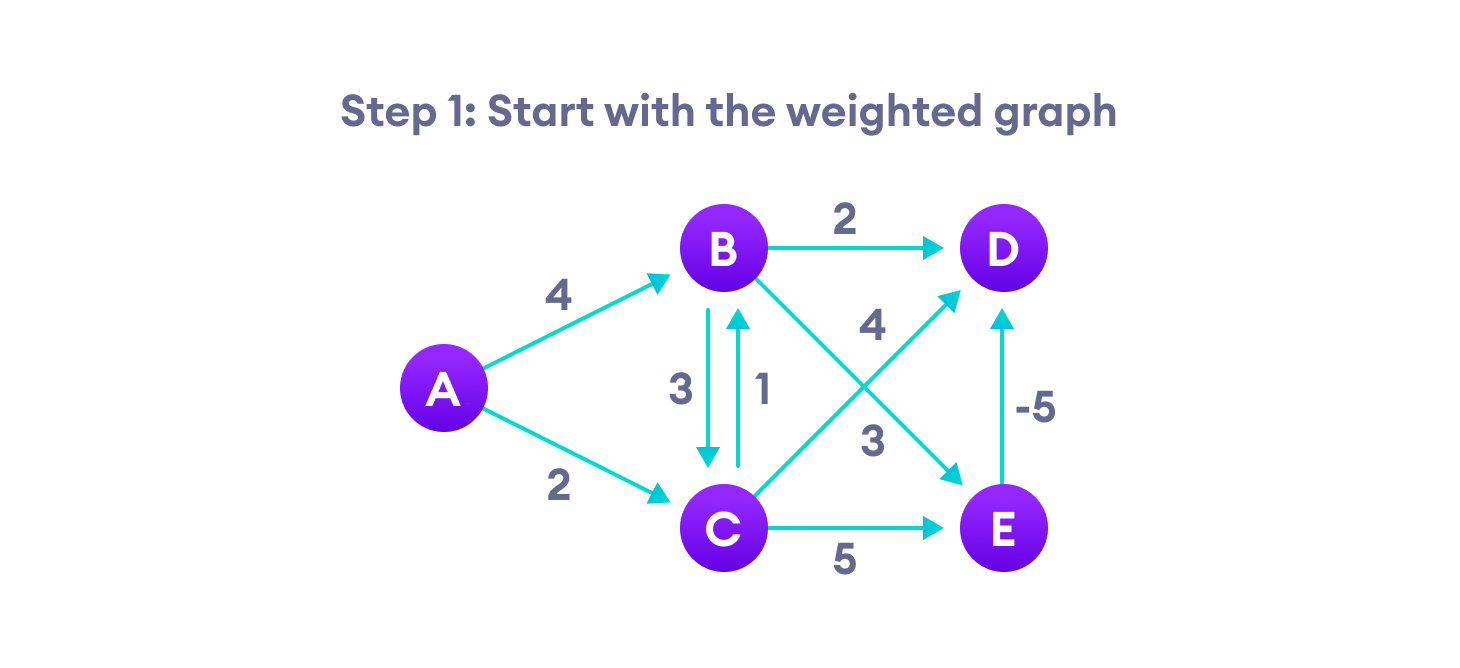
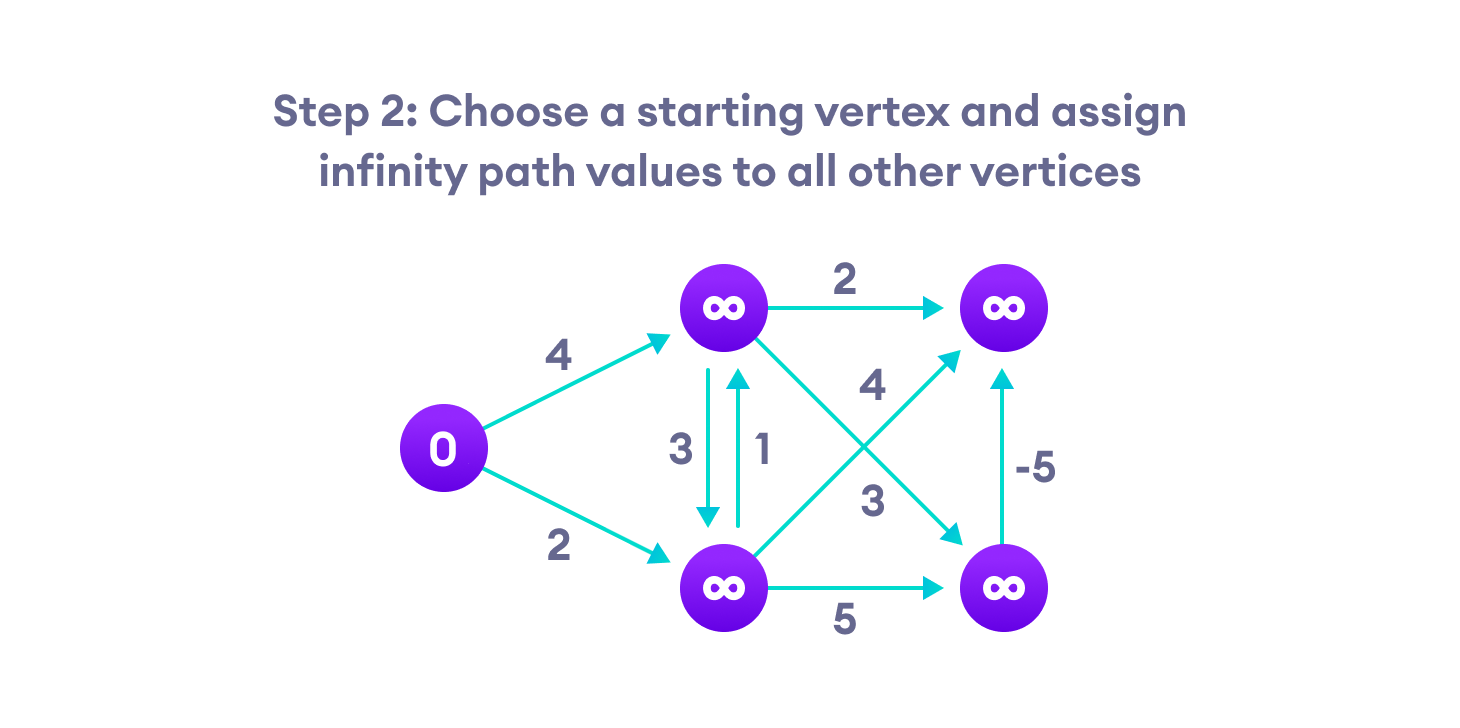
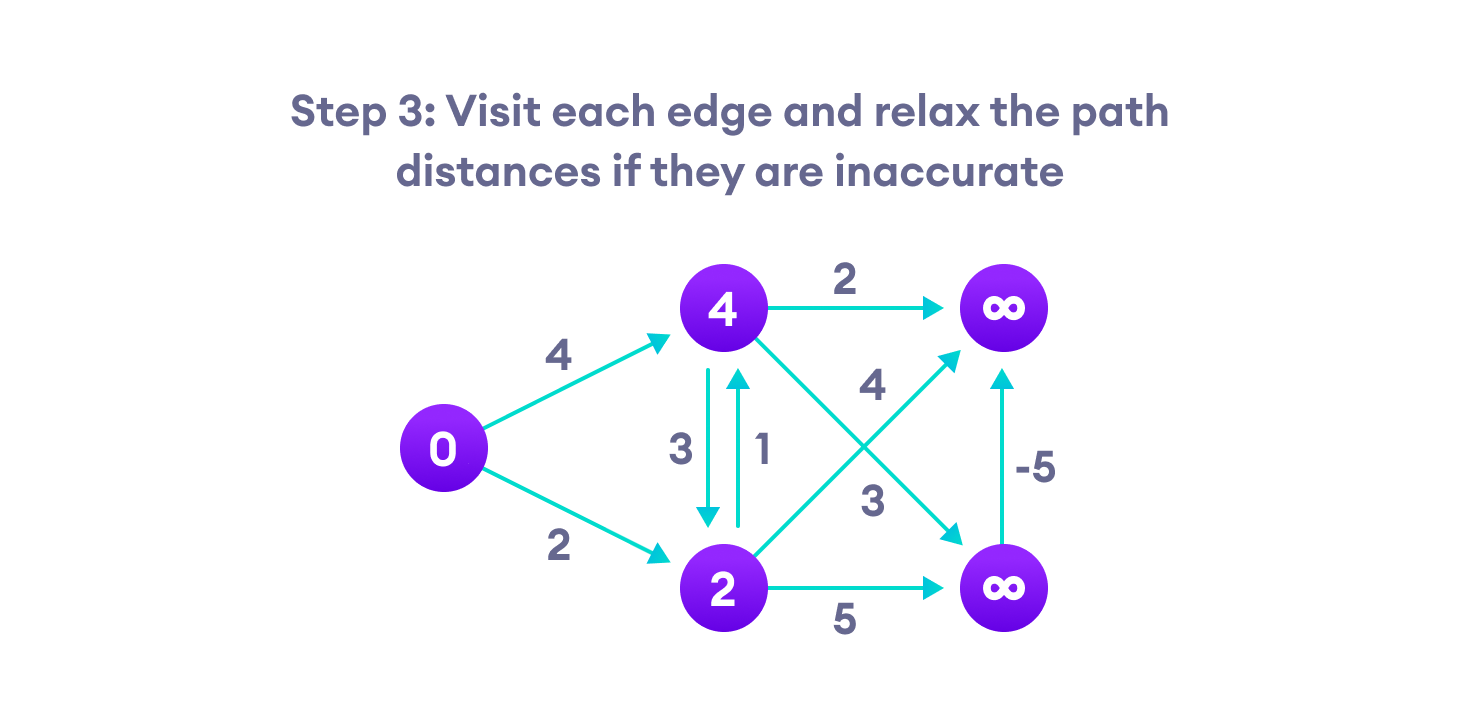
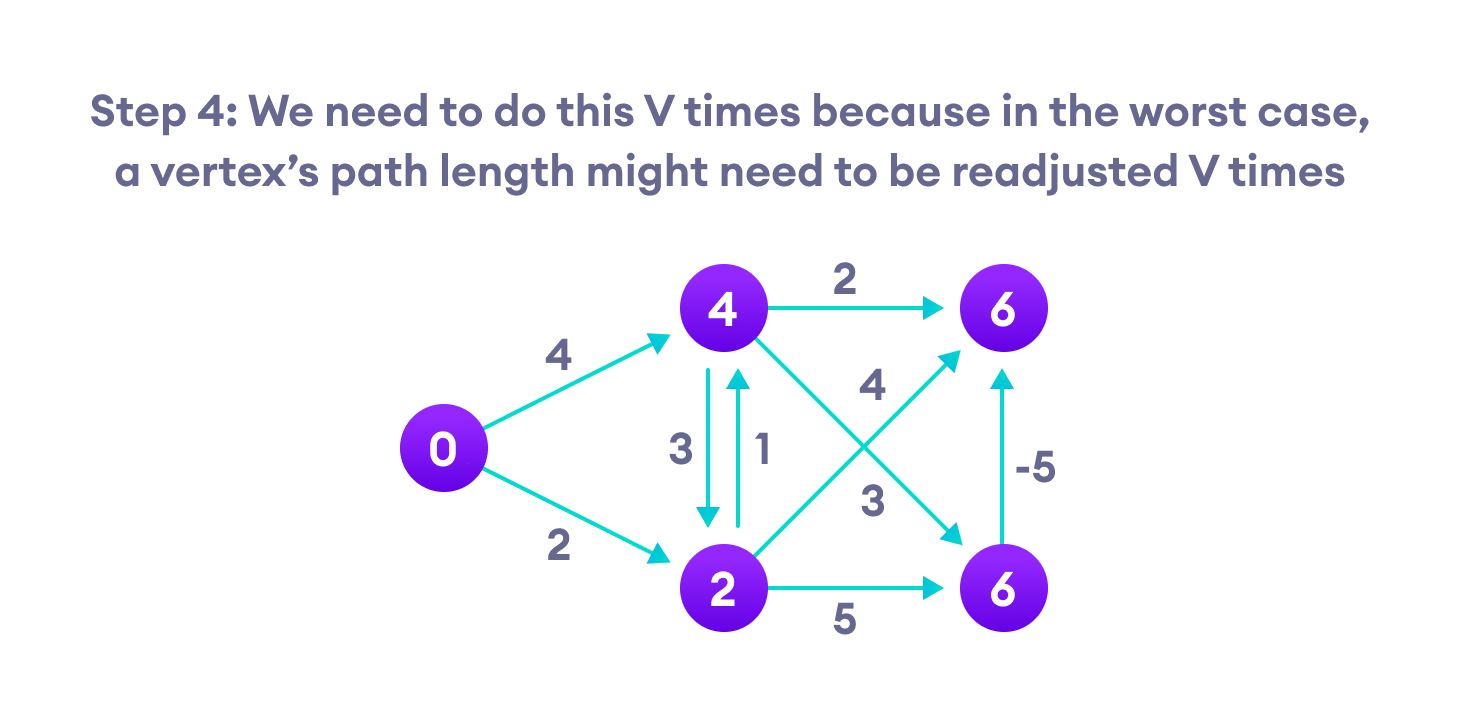
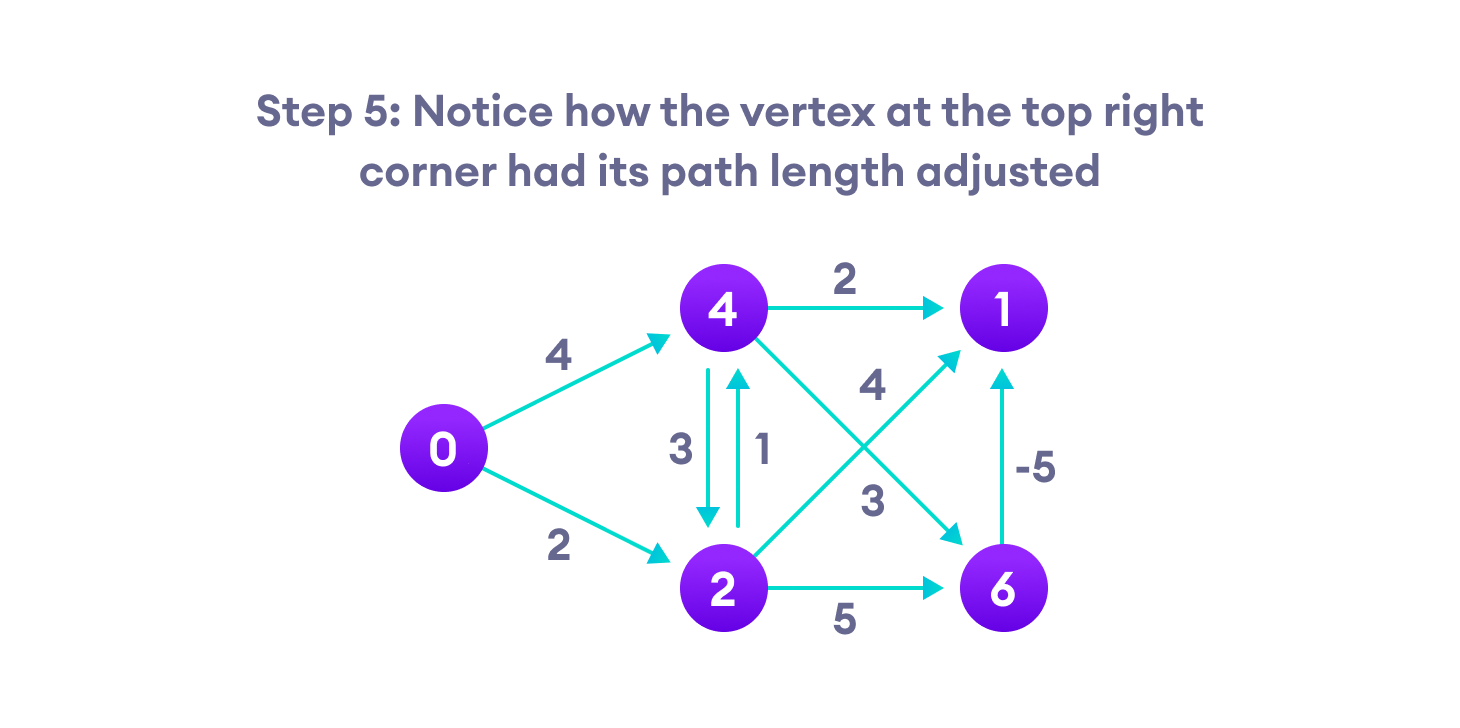
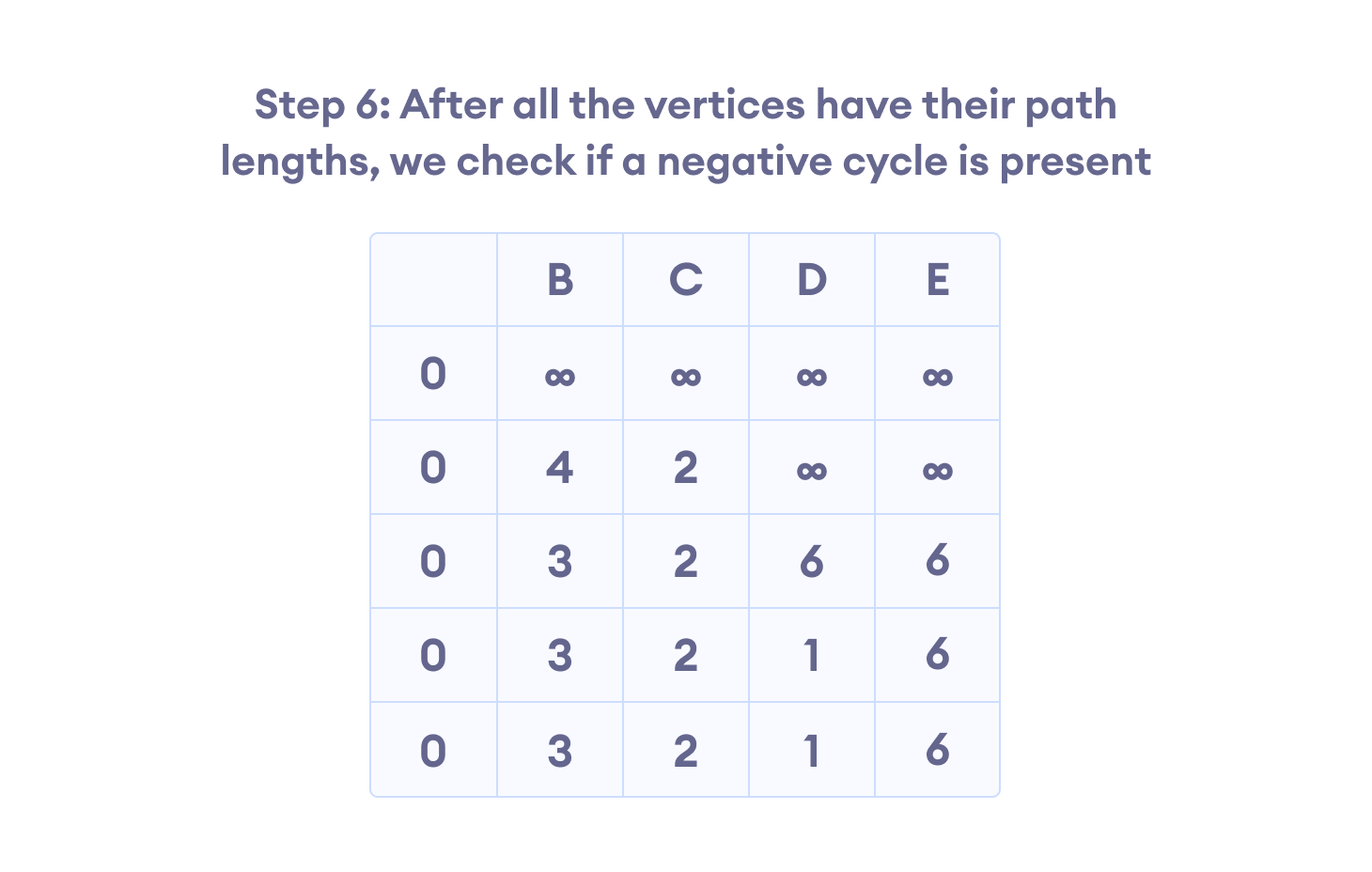
贝尔曼·福特伪代码
我们需要保持每个顶点的路径距离。我们可以将其存储在大小为v的数组中,其中v是顶点数。
我们还希望能够获得最短路径,而不仅知道最短路径的长度。为此,我们将每个顶点映射到最后更新其路径长度的顶点。
算法结束后,我们可以从目标顶点回溯到源顶点以找到路径。
function bellmanFord(G, S)
for each vertex V in G
distance[V] 贝尔曼·福特vs迪克斯特拉
Bellman Ford算法和Dijkstra算法在结构上非常相似。虽然Dijkstra仅查找顶点的直接邻居,但Bellman在每次迭代中都会遍历每个边。
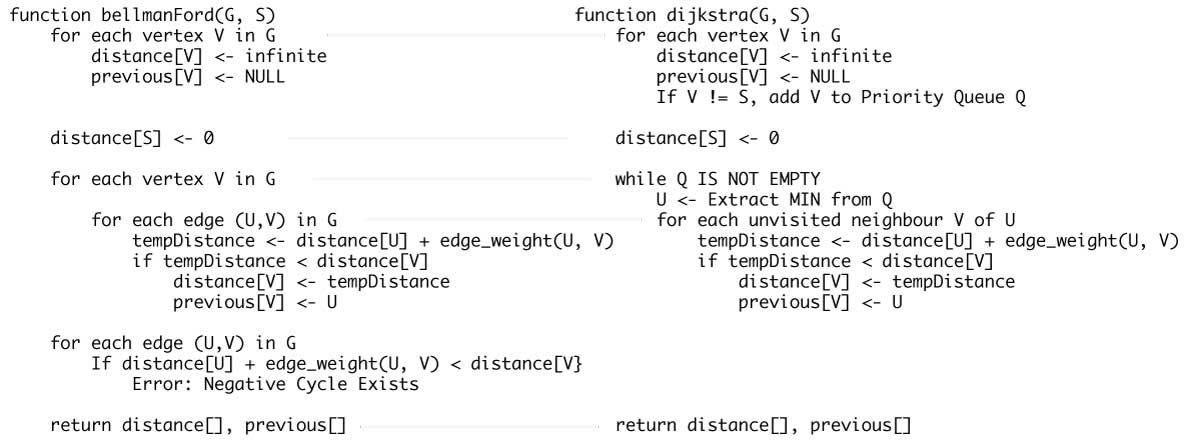
Python,Java和C / C++示例
Python
爪哇
C
C++
# Bellman Ford Algorithm in Python
class Graph:
def __init__(self, vertices):
self.V = vertices # Total number of vertices in the graph
self.graph = [] # Array of edges
# Add edges
def add_edge(self, s, d, w):
self.graph.append([s, d, w])
# Print the solution
def print_solution(self, dist):
print("Vertex Distance from Source")
for i in range(self.V):
print("{0}\t\t{1}".format(i, dist[i]))
def bellman_ford(self, src):
# Step 1: fill the distance array and predecessor array
dist = [float("Inf")] * self.V
# Mark the source vertex
dist[src] = 0
# Step 2: relax edges |V| - 1 times
for _ in range(self.V - 1):
for s, d, w in self.graph:
if dist[s] != float("Inf") and dist[s] + w < dist[d]:
dist[d] = dist[s] + w
# Step 3: detect negative cycle
# if value changes then we have a negative cycle in the graph
# and we cannot find the shortest distances
for s, d, w in self.graph:
if dist[s] != float("Inf") and dist[s] + w < dist[d]:
print("Graph contains negative weight cycle")
return
# No negative weight cycle found!
# Print the distance and predecessor array
self.print_solution(dist)
g = Graph(5)
g.add_edge(0, 1, 5)
g.add_edge(0, 2, 4)
g.add_edge(1, 3, 3)
g.add_edge(2, 1, 6)
g.add_edge(3, 2, 2)
g.bellman_ford(0)// Bellman Ford Algorithm in Java
class CreateGraph {
// CreateGraph - it consists of edges
class CreateEdge {
int s, d, w;
CreateEdge() {
s = d = w = 0;
}
};
int V, E;
CreateEdge edge[];
// Creates a graph with V vertices and E edges
CreateGraph(int v, int e) {
V = v;
E = e;
edge = new CreateEdge[e];
for (int i = 0; i < e; ++i)
edge[i] = new CreateEdge();
}
void BellmanFord(CreateGraph graph, int s) {
int V = graph.V, E = graph.E;
int dist[] = new int[V];
// Step 1: fill the distance array and predecessor array
for (int i = 0; i < V; ++i)
dist[i] = Integer.MAX_VALUE;
// Mark the source vertex
dist[s] = 0;
// Step 2: relax edges |V| - 1 times
for (int i = 1; i < V; ++i) {
for (int j = 0; j < E; ++j) {
// Get the edge data
int u = graph.edge[j].s;
int v = graph.edge[j].d;
int w = graph.edge[j].w;
if (dist[u] != Integer.MAX_VALUE && dist[u] + w < dist[v])
dist[v] = dist[u] + w;
}
}
// Step 3: detect negative cycle
// if value changes then we have a negative cycle in the graph
// and we cannot find the shortest distances
for (int j = 0; j < E; ++j) {
int u = graph.edge[j].s;
int v = graph.edge[j].d;
int w = graph.edge[j].w;
if (dist[u] != Integer.MAX_VALUE && dist[u] + w < dist[v]) {
System.out.println("CreateGraph contains negative w cycle");
return;
}
}
// No negative w cycle found!
// Print the distance and predecessor array
printSolution(dist, V);
}
// Print the solution
void printSolution(int dist[], int V) {
System.out.println("Vertex Distance from Source");
for (int i = 0; i < V; ++i)
System.out.println(i + "\t\t" + dist[i]);
}
public static void main(String[] args) {
int V = 5; // Total vertices
int E = 8; // Total Edges
CreateGraph graph = new CreateGraph(V, E);
// edge 0 --> 1
graph.edge[0].s = 0;
graph.edge[0].d = 1;
graph.edge[0].w = 5;
// edge 0 --> 2
graph.edge[1].s = 0;
graph.edge[1].d = 2;
graph.edge[1].w = 4;
// edge 1 --> 3
graph.edge[2].s = 1;
graph.edge[2].d = 3;
graph.edge[2].w = 3;
// edge 2 --> 1
graph.edge[3].s = 2;
graph.edge[3].d = 1;
graph.edge[3].w = 6;
// edge 3 --> 2
graph.edge[4].s = 3;
graph.edge[4].d = 2;
graph.edge[4].w = 2;
graph.BellmanFord(graph, 0); // 0 is the source vertex
}
}// Bellman Ford Algorithm in C
#include
#include
#define INFINITY 99999
//struct for the edges of the graph
struct Edge {
int u; //start vertex of the edge
int v; //end vertex of the edge
int w; //weight of the edge (u,v)
};
//Graph - it consists of edges
struct Graph {
int V; //total number of vertices in the graph
int E; //total number of edges in the graph
struct Edge *edge; //array of edges
};
void bellmanford(struct Graph *g, int source);
void display(int arr[], int size);
int main(void) {
//create graph
struct Graph *g = (struct Graph *)malloc(sizeof(struct Graph));
g->V = 4; //total vertices
g->E = 5; //total edges
//array of edges for graph
g->edge = (struct Edge *)malloc(g->E * sizeof(struct Edge));
//------- adding the edges of the graph
/*
edge(u, v)
where u = start vertex of the edge (u,v)
v = end vertex of the edge (u,v)
w is the weight of the edge (u,v)
*/
//edge 0 --> 1
g->edge[0].u = 0;
g->edge[0].v = 1;
g->edge[0].w = 5;
//edge 0 --> 2
g->edge[1].u = 0;
g->edge[1].v = 2;
g->edge[1].w = 4;
//edge 1 --> 3
g->edge[2].u = 1;
g->edge[2].v = 3;
g->edge[2].w = 3;
//edge 2 --> 1
g->edge[3].u = 2;
g->edge[3].v = 1;
g->edge[3].w = 6;
//edge 3 --> 2
g->edge[4].u = 3;
g->edge[4].v = 2;
g->edge[4].w = 2;
bellmanford(g, 0); //0 is the source vertex
return 0;
}
void bellmanford(struct Graph *g, int source) {
//variables
int i, j, u, v, w;
//total vertex in the graph g
int tV = g->V;
//total edge in the graph g
int tE = g->E;
//distance array
//size equal to the number of vertices of the graph g
int d[tV];
//predecessor array
//size equal to the number of vertices of the graph g
int p[tV];
//step 1: fill the distance array and predecessor array
for (i = 0; i < tV; i++) {
d[i] = INFINITY;
p[i] = 0;
}
//mark the source vertex
d[source] = 0;
//step 2: relax edges |V| - 1 times
for (i = 1; i <= tV - 1; i++) {
for (j = 0; j < tE; j++) {
//get the edge data
u = g->edge[j].u;
v = g->edge[j].v;
w = g->edge[j].w;
if (d[u] != INFINITY && d[v] > d[u] + w) {
d[v] = d[u] + w;
p[v] = u;
}
}
}
//step 3: detect negative cycle
//if value changes then we have a negative cycle in the graph
//and we cannot find the shortest distances
for (i = 0; i < tE; i++) {
u = g->edge[i].u;
v = g->edge[i].v;
w = g->edge[i].w;
if (d[u] != INFINITY && d[v] > d[u] + w) {
printf("Negative weight cycle detected!\n");
return;
}
}
//No negative weight cycle found!
//print the distance and predecessor array
printf("Distance array: ");
display(d, tV);
printf("Predecessor array: ");
display(p, tV);
}
void display(int arr[], int size) {
int i;
for (i = 0; i < size; i++) {
printf("%d ", arr[i]);
}
printf("\n");
} // Bellman Ford Algorithm in C++
#include
// Struct for the edges of the graph
struct Edge {
int u; //start vertex of the edge
int v; //end vertex of the edge
int w; //w of the edge (u,v)
};
// Graph - it consists of edges
struct Graph {
int V; // Total number of vertices in the graph
int E; // Total number of edges in the graph
struct Edge* edge; // Array of edges
};
// Creates a graph with V vertices and E edges
struct Graph* createGraph(int V, int E) {
struct Graph* graph = new Graph;
graph->V = V; // Total Vertices
graph->E = E; // Total edges
// Array of edges for graph
graph->edge = new Edge[E];
return graph;
}
// Printing the solution
void printArr(int arr[], int size) {
int i;
for (i = 0; i < size; i++) {
printf("%d ", arr[i]);
}
printf("\n");
}
void BellmanFord(struct Graph* graph, int u) {
int V = graph->V;
int E = graph->E;
int dist[V];
// Step 1: fill the distance array and predecessor array
for (int i = 0; i < V; i++)
dist[i] = INT_MAX;
// Mark the source vertex
dist[u] = 0;
// Step 2: relax edges |V| - 1 times
for (int i = 1; i <= V - 1; i++) {
for (int j = 0; j < E; j++) {
// Get the edge data
int u = graph->edge[j].u;
int v = graph->edge[j].v;
int w = graph->edge[j].w;
if (dist[u] != INT_MAX && dist[u] + w < dist[v])
dist[v] = dist[u] + w;
}
}
// Step 3: detect negative cycle
// if value changes then we have a negative cycle in the graph
// and we cannot find the shortest distances
for (int i = 0; i < E; i++) {
int u = graph->edge[i].u;
int v = graph->edge[i].v;
int w = graph->edge[i].w;
if (dist[u] != INT_MAX && dist[u] + w < dist[v]) {
printf("Graph contains negative w cycle");
return;
}
}
// No negative weight cycle found!
// Print the distance and predecessor array
printArr(dist, V);
return;
}
int main() {
// Create a graph
int V = 5; // Total vertices
int E = 8; // Total edges
// Array of edges for graph
struct Graph* graph = createGraph(V, E);
//------- adding the edges of the graph
/*
edge(u, v)
where u = start vertex of the edge (u,v)
v = end vertex of the edge (u,v)
w is the weight of the edge (u,v)
*/
//edge 0 --> 1
graph->edge[0].u = 0;
graph->edge[0].v = 1;
graph->edge[0].w = 5;
//edge 0 --> 2
graph->edge[1].u = 0;
graph->edge[1].v = 2;
graph->edge[1].w = 4;
//edge 1 --> 3
graph->edge[2].u = 1;
graph->edge[2].v = 3;
graph->edge[2].w = 3;
//edge 2 --> 1
graph->edge[3].u = 2;
graph->edge[3].v = 1;
graph->edge[3].w = 6;
//edge 3 --> 2
graph->edge[4].u = 3;
graph->edge[4].v = 2;
graph->edge[4].w = 2;
BellmanFord(graph, 0); //0 is the source vertex
return 0;
} 贝尔曼·福特的复杂性
时间复杂度
| Best Case Complexity | O(E) |
| Average Case Complexity | O(VE) |
| Worst Case Complexity | O(VE) |
空间复杂度
并且,空间复杂度为O(V) 。
贝尔曼·福特算法应用
- 用于计算路由算法中的最短路径
- 寻找最短路径